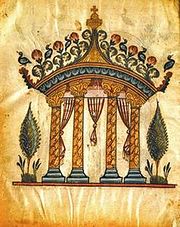
Echmiadzin Gospel
Encyclopedia

Armenia
Armenia , officially the Republic of Armenia , is a landlocked mountainous country in the Caucasus region of Eurasia...
n Gospel Book
Gospel Book
The Gospel Book, Evangelion, or Book of the Gospels is a codex or bound volume containing one or more of the four Gospels of the Christian New Testament...
produced in 989 at the Monastery of Bgheno-Noravank
Bgheno-Noravank
Bgheno-Noravank Monastery is an 11th century Armenian monastery in the Syunik Marz of Armenia. It now consists of a small church dating to 1062, located on a little wooded promontory, and ornately decorated with borders and biblical reliefs...
in Syunik
Syunik
Syunik is the southernmost province of Armenia. It borders the Vayots Dzor marz to the north, Azerbaijan's Nakhchivan exclave to the west, Karabakh to the east, and Iran to the south. Its capital is Kapan. Other important cities and towns include Goris, Sisian, Meghri, Agarak, and Dastakert...
.
The book
The manuscript has 232 extant leaves which measure approximately 32 by 25.5 cm. The book was made under the patronage of bishop Stepanos and written by the scribe Hovhanes. The binding of the book is made of two carved ivoryIvory
Ivory is a term for dentine, which constitutes the bulk of the teeth and tusks of animals, when used as a material for art or manufacturing. Ivory has been important since ancient times for making a range of items, from ivory carvings to false teeth, fans, dominoes, joint tubes, piano keys and...
plaques, probably of Byzantine manufacture of the 6th century. Bound into the book are two leaves (fols. 228-229) with miniatures dating to the late 6th—early 7th century (so-called 'Final Four Miniatures').
Eusebian Canons

Eusebius of Caesarea
Eusebius of Caesarea also called Eusebius Pamphili, was a Roman historian, exegete and Christian polemicist. He became the Bishop of Caesarea in Palestine about the year 314. Together with Pamphilus, he was a scholar of the Biblical canon...
(1st half of the 4th century). Taking into account the Caesarean type
Caesarean text-type
Caesarean text-type is the term proposed by certain scholars to denote a consistent pattern of variant readings that is claimed to be apparent in certain Greek manuscripts of the four Gospels, but which is not found in any of the other commonly recognized New Testament text-types; the Byzantine...
of the Armenian text of the Gospels, Nordenfalk concluded that the Echmiadzin Gospels were copied from a Caesarean codex equipped with the Eusebian canon tables.
External links
- Index of Armenian Art: Manuscripts:Matenadaran, Ms. 2374, Etchmiadzin Gospels, the 'Final Four Miniatures' (short description, page images)

